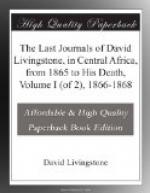26th April, 1866.—On the 25th we reached Narri, and resolved to wait the next day and buy food, as it is not so plentiful in front; the people are eager traders in meal, fowls, eggs, and honey; the women are very rude. Yesterday I caught a sepoy, Pando, belabouring a camel with a big stick as thick as any part of his arm, the path being narrow, it could not get out of his way; I shouted to him to desist; he did not know I was in sight, to-day the effect of the bad usage is seen in the animal being quite unable to move its leg: inflammation has set up in the hip-joint. I am afraid that several bruises which have festered on the camels, and were to me unaccountable, have been wilfully bestowed. This same Pando and another left Zanzibar drunk: he then stole a pair of socks from me, and has otherwise been perfectly useless, even a pimple on his leg was an excuse for doing nothing for many days. We had to leave this camel at Narri under charge of the headman.
28th April, 1866.—The hills on the north now retire out of our sight. A gap in the southern plateau gives passage to a small river, which arises in a lakelet of some size, eight or ten miles inland: the river and lakelet are both called Nangadi; the latter is so broad that men cannot be distinguished, even by the keen eyes of the natives on the other side: it is very deep, and abounds in large fish; the people who live there are Mabiha. A few miles above this gap the southern highland falls away, and there are lakelets on marshes, also abounding in fish, an uninhabited space next succeeds, and then we have the Matambwe country, which extends up to Ngomano. The Matambwe seem to be a branch of the Makonde, and a very large one: their country extends a long way south, and is well stocked with elephants and gum-copal trees.
They speak a language slightly different from that of the Makonde, but they understand them. The Matambwe women are, according to Ali, very dark, but very comely, though they do wear the lip-ring. They carry their ivory, gum-copal, and slaves to Ibo or Wibo.
29th April, 1866.—We spend Sunday, the 29th, on the banks of the Rovuma, at a village called Nachuchu, nearly opposite Konayumba, the first of the Matambwe, whose chief is called Kimbembe. Ali draws a very dark picture of the Makonde. He says they know nothing of a Deity, they pray to their mothers when in distress or dying; know nothing of a future state, nor have they any religion except a belief in medicine; and every headsman is a doctor. No Arab has ever tried to convert them, but occasionally a slave taken to the coast has been circumcised in order to be clean; some of them pray, and say they know not the ordeal or muavi. The Nassick boys failed me when I tried to communicate some knowledge through them. They say they do not understand the Makonde language, though some told me that they came from Ndonde’s, which is the head-quarters of the Makonde. Ali says that the Makonde blame




